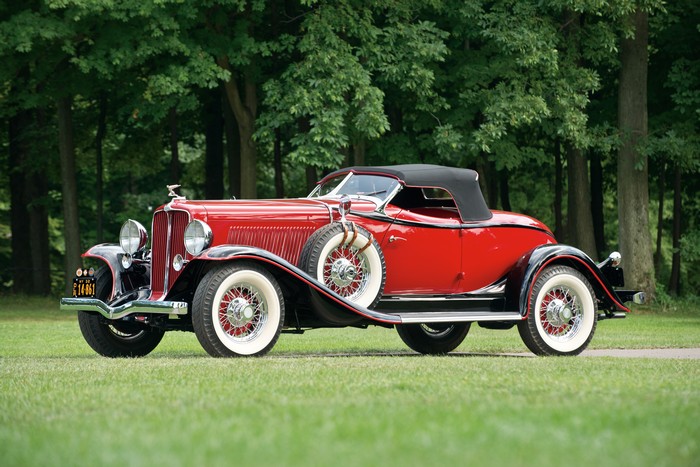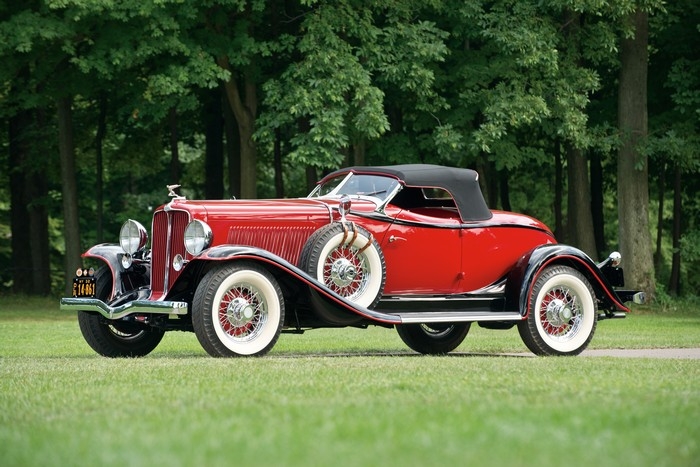
The 1932 Auburn 8-100A Speedster was the Auburn Automobile Company’s most spectacular 8-cylinder offering — an ideal Depression-era road machine for those who could afford it. It offered outstanding performance for a dashing couple, with the flexibility of a 2-speed rear axle providing a low ratio for city use and a high ratio for open roads in all three gears. Today, few Auburn products are more desirable.
This Speedster has been certified as Category One by the Auburn Cord Duesenberg Club, as it has an original 8-100A chassis, engine, transmission, axles, body and all other major components. It is crucial to note the originality of the body, which was built for Auburn by Union City Body Company.
The present owner acquired the Speedster body in 1989 and, with the goal of creating a perfect show car, spent five years restoring it on an original 8-100A chassis that was born with sedan coachwork.
It has subsequently been judged a Senior Grand National winner by the Antique Automobile Club of America, and it has reached Senior Premier status in the Classic Car Club of America. The most recent award was earned at the Concours d’Elegance of America at St. John’s in 2012 — 18 years after the completion of the restoration.
SCM Analysis
Detailing
| Vehicle: | 1932 Auburn 8-100A speedster |
| Years Produced: | 1932 |
| Number Produced: | 84 |
| Original List Price: | $845 |
| SCM Valuation: | $250,000–$350,000 |
| Tune Up Cost: | $300 |
| Distributor Caps: | $125 |
| Chassis Number Location: | Left frame rail |
| Engine Number Location: | Left side of crankcase |
| Club Info: | Auburn-Cord-Duesenberg Club |
| Website: | www.acdclub.org |
| Alternatives: | 1929–34 Duesenberg Model J (closed), 1934 Packard Twelve Coupe Roadster, 1937 Cord 812 SC Sportsman |
| Investment Grade: | B |
This Auburn 8-100A Speedster, Lot 158, sold for $330,000, including buyer’s premium, at RM’s Amelia Island Auction on March 9, 2013, in Amelia Island, FL.
Auburn would have most likely closed their doors in the mid-’20s had it not been for the arrival of E.L. Cord. Cord was a cocky but successful salesman, and he was able to convince the AAC Board that he was their only hope of recouping their investments. In turn, he worked the deal in his benefit — he eventually owned the company. He was then faced with an inventory of more than 700 Auburns collecting dust on the back lots and enough parts and pieces to assemble at least that many more.
Streamlining the Auburn
He quickly strengthened the dealer network, and he pushed forward on design, following his belief in “be different if you can’t be the biggest.” Under that directive, Auburn introduced the Model 115 Speedster in 1928. The car featured a steeply raked windshield and streamlined boattail rear end. The Speedster design was as much substance as style, as it eliminated the ability for a competitor to draft in racing competition.
The new design, based on the 1927 Duesenberg Model X Speedster, exuded momentum even when standing still. It set a new AAA one-mile stock-car record of 104.347 miles per hour on February 28, 1928, at Daytona Beach. Because of that run, to the buying public, Auburn was quickly equated with performance.
Enter a youthful Alan Leamy, who was hired as a designer. At the age of 28, his work on the 1932 Auburn Speedster was dramatic and groundbreaking, with stunning and flowing integrated lines. But the Great Depression was taking its toll on the buying public, and priced at $845, a mere 84 8-100 Speedsters were produced. The Auburn Model 8-100A custom model was equipped with a Columbia dual-ratio rear axle, free-wheeling, Bijur chassis lubrication system, ride control shocks, and a Startix automatic starter.
Awards and issues
The 1932 Auburn 8-100A Speedster offered by RM was stunning in red and black, and the chrome wire wheels set off the entire presentation. The car had a long list of awards and a Category One Certification from the ACD Club. In short, it looked great, was extremely well detailed, and it seemed to have all of the provenance it needed. It was a very high-level package with exquisite detailing. There were, however, a few discrepancies.
First, the 8-100A chassis used in this particular car was from a sedan. It had been married to this original Union City Body Company speedster body in 1989. Technically, since it was a rebody (even with an original piece), the car wouldn’t qualify for a Category One Certification, although a few others also slipped by as the judging process was being refined. It does have the certification, but it also has a story to go along with it.
The Auburn was also finished with urethane paint, which while very well done, would be a serious deduction in many judging circles.
And finally, there was a grille-fit issue. One of the trickiest parts of restoring Auburns is fitting the “pitchfork” grille molding into the lower splash pan trim. This car’s pieces were not even close to lining up — the owner readily admitted the deficiency. But he had to — there really wasn’t any way to hide it.
The sum of its parts or more?
Does any of this suggest the $330,000 sale price was out of line? I think not, as this is still one of the best examples available of the most revered Auburn 8 from the golden age of pre-war motoring. The grille trim can be corrected for a couple thousand dollars, the ACD Club can’t alter their certification without facing potential legal issues, and the paint, while not period-correct, will only be a concern if the new owner wants to continue to show the car.
But since the car has already been to most of the rodeos, why not just use and enjoy it? It’s a rare piece no matter how you hash it, and it’ll literally stop traffic wherever you take it.
Regardless of the car’s next step — be it show field or open road — at the price paid, I’d call it both well bought and well sold.
(Introductory description courtesy of RM Auctions.)
